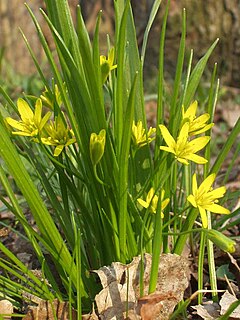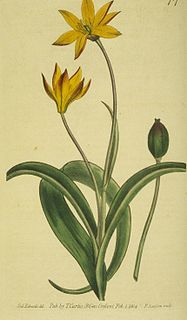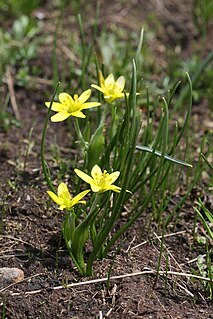
Gagea is a large genus of spring flowers in the lily family. It is found primarily in Eurasia with a few species extending into North Africa and North America.

Gagea bohemica, the early star-of-Bethlehem or Radnor lily, is a European and Mediterranean species of flowering plant in the lily family. It is sometimes referred to as the Welsh Star-of-Bethlehem.

Gagea serotina, synonym Lloydia serotina, is an Arctic–alpine flowering plant of the lily family. It is widespread across the mountainous parts of western North America, from Alaska to New Mexico, and in Europe is found in the Alps and Carpathians, as well as in Great Britain. It is also native to much of Central Asia, Siberia, China, Nepal, Mongolia, Korea and Japan.

An Arctic–alpine taxon is one whose natural distribution includes the Arctic and more southerly mountain ranges, particularly the Alps. The presence of identical or similar taxa in both the tundra of the far north, and high mountain ranges much further south is testament to the similar environmental conditions found in the two locations. Arctic–alpine plants, for instance, must be adapted to the low temperatures, extremes of temperature, strong winds and short growing season; they are therefore typically low-growing and often form mats or cushions to reduce water loss through evapotranspiration.

The Lilioideae are a subfamily of monocotyledon perennial, herbaceous mainly bulbous flowering plants in the lily family, Liliaceae. They are found predominantly in the temperate and colder regions of the Northern Hemisphere, particularly East Asia and North America. The subfamily includes two tribes. They are of economic importance, particularly the lilies and tulips.
The Lloydieae were a tribe of monocotyledon perennial, herbaceous mainly bulbous flowering plants in the Liliaceae (Lily) family. The tribe was generally considered monogeric, being represented by the single genus Lloydia. But since that genus has at various times and is now considered to be part of the genus Gagea, and therefore in the tribe Lilieae, it was sometimes listed with both genera. Furthermore many authorities place Gagea into a separate tribe, Tulipeae. It has also historically been considered to be a subtribe of the Lilieae. In 2013, Kim et al. proposed splitting off Gagea from the rest of Tulipeae by resurrecting the tribe Lloydieae.

The TulipeaeDuby is a tribe of monocotyledon perennial, herbaceous mainly bulbous flowering plants in the Liliaceae (Lily) family. As originally conceived by Duby (1828), "Tulipaceae" was a tribe within Liliaceae, consisting of the genera Tulipa, Fritillaria and Lilium.

The taxonomy of Liliaceae has had a complex history since the first description of this flowering plant family in the mid-eighteenth century. Originally, the Liliaceae or Lily family were defined as having a "calix" (perianth) of six equal-coloured parts, six stamens, a single style, and a superior, three-chambered (trilocular) ovary turning into a capsule fruit at maturity. The taxonomic circumscription of the family Liliaceae progressively expanded until it became the largest plant family and also extremely diverse, being somewhat arbitrarily defined as all species of plants with six tepals and a superior ovary. It eventually came to encompass about 300 genera and 4,500 species, and was thus a "catch-all" and hence paraphyletic taxon. Only since the more modern taxonomic systems developed by the Angiosperm Phylogeny Group (APG) and based on phylogenetic principles, has it been possible to identify the many separate taxonomic groupings within the original family and redistribute them, leaving a relatively small core as the modern family Liliaceae, with fifteen genera and 600 species.

Gagea liotardii is a Eurasian and North African species of plants in the lily family. It is a bulb-forming perennial up to 15 cm tall. Flowers are generally bright yellow to yellow-green. Its native range stretches from Spain and Morocco to Mongolia.

Gagea alberti is an Asian species of plants in the lily family, native to Kazakhstan, Kyrgyzstan and Xinjiang Province of western China.
Gagea bulbifera is a Eurasian species of plants in the lily family, widespread from Romania to Xinjiang. It is native to Romania, Russia, South Caucasus, Kazakhstan, Kyrgyzstan, Iran, Turkey, Xinjiang, Western Himalayas.
Gagea filiformis is an Asian species of plants in the lily family, native to Russia, China (Xinjiang), Kazakhstan, Kyrgyzstan, Tajikistan, Uzbekistan, Afghanistan, Pakistan, and Mongolia.
Gagea nakaiana is an Asian species of plants in the lily family. It is native to northeastern China, Russia, Japan, Korea, Nepal, Bhutan, Pakistan, and northern India.
Gagea neopopovii is an Asian species of plants in the lily family. It is native to Xinjiang and Kazakhstan
Gagea olgae is an Asian species of plants in the lily family. It is native to Iran, Pakistan, Afghanistan, Kyrgyzstan, Tajikistan, Uzbekistan, Kazakhstan, and Xinjiang.
Gagea kunawurensis is an Asian species of plants in the lily family. It is native to Central Asia, Xinjiang, Afghanistan, Iran, Pakistan, Western Himalayas, and South Caucasus.
Gagea pauciflora is an Asian species of plants in the lily family. It is native to Mongolia, Russia, and China.
Gagea stepposa is a Chinese flowering plant in the lily family. It is found only in the northern part of Xinjiang Province in northwestern China.
Gagea tenera is an Asian species of flowering plants in the lily family. It is native to Xinjiang, Central Asia, the Western Himalayas, Iran, Turkey, and South Caucasus.
Gagea triflora is an Asian species of plants in the lily family. It is native to Japan, Korea, China, and Russia.







